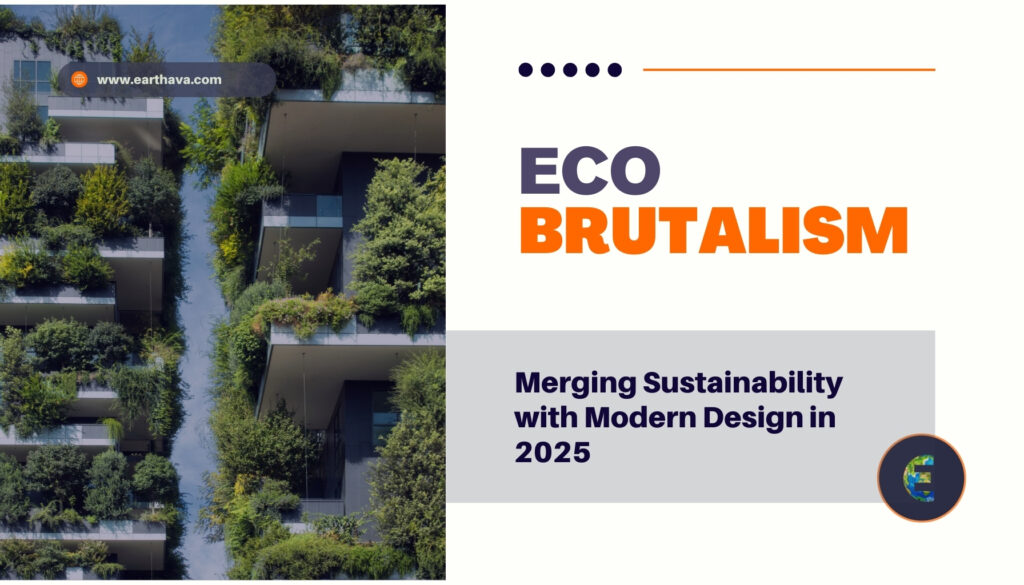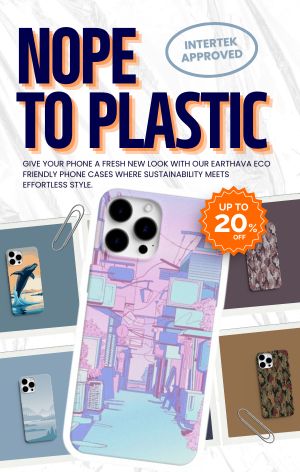What if the future of architecture blended raw concrete with lush greenery? In 2025, Eco-Brutalism is redefining urban spaces by merging industrial strength with environmental harmony. This design movement proves sustainability and bold aesthetics can coexist, transforming cities into greener, more resilient landscapes.

Traditional Brutalism prioritized function, but today’s innovators add a critical layer: eco-consciousness. By integrating plants, solar panels, and recycled materials, architects are cutting the concrete industry’s 8% global CO₂ footprint. The result? Striking structures that serve both people and the planet.
Key Takeaways
- Eco-Brutalism combines concrete durability with sustainable design.
- 2025 marks a turning point for green architecture innovations.
- Social media is accelerating the trend’s popularity.
- New tech makes concrete more eco-friendly.
- This style bridges industrial history with a green future.
What Is Eco-Brutalism? The Ultimate Guide to Sustainable Modern Design
Imagine towering structures where rugged concrete meets cascading vines, welcome to the world of sustainable modern design. This architectural style, often called Eco-Brutalism, blends raw materials with living ecosystems. It’s not just about looks; it’s a movement that prioritizes both functionality and environmental healing.
Defining Eco-Brutalism: A Fusion of Concrete and Greenery
At its core, this style rethinks traditional brutalism by weaving nature into its framework. Think vertical gardens on concrete facades or solar panels embedded in raw structures. Take Moshe Safdie’s Habitat 67, a pioneer project with 354 modular blocks, each boasting private gardens. Studies show such designs reduce urban heat by 67%.
How Eco-Brutalism Differs from Traditional Brutalism
Post-war brutalism focused on pragmatism, often ignoring environmental costs. Today’s version flips the script:
| Aspect | Traditional Brutalism | Eco-Brutalism |
|---|---|---|
| Materials | Steel, bare concrete | Carbon-absorbing concrete, recycled metals |
| Energy Use | High | Solar-integrated, passive cooling |
| Nature Integration | Minimal | 40% air quality boost with green walls |
Myths persist about concrete’s sustainability, but 2025 innovations prove otherwise. New certifications now reward projects that balance durability with eco-ethics. The Georgian Ministry building, draped in living vines, stands as a testament to this shift.
The Origins and Evolution of Brutalism
Cold War tensions influenced an architectural revolution of rugged designs. Born from post-war pragmatism, Brutalism prioritized function over ornament, using raw concrete to rebuild cities. Today, we see its rebirth through sustainable lenses, a testament to its enduring adaptability.
Post-War Pragmatism: The Birth of Brutalist Architecture
The 1950s demanded affordable, durable housing. Architects like Alison and Peter Smithson answered with Robin Hood Gardens, two concrete towers designed for London’s working class. Budget cuts slashed 21% of funds, compromising functionality but cementing its iconic status.
Eastern Bloc nations embraced Brutalism for ideological expression. These monolithic structures symbolized collective strength, from Poland’s Spodek Arena to Bulgaria’s Buzludzha Monument.
From Utopian Ideals to Modern Revival
Thatcher-era policies demolished 73% of London’s Brutalist landmarks, branding them as eyesores. Yet, 2023 brought UNESCO recognition for gems like Boston City Hall. The shift reflects a growing appreciation for Brutalism’s historical value.
| Era | Materials | Purpose |
|---|---|---|
| 1950s–1970s | Bare concrete, steel | Mass housing, low-cost |
| 2020s Revival | Recycled concrete, 3D-printed elements | Sustainability, heritage preservation |
Key Examples: Habitat 67 and Robin Hood Gardens
Moshe Safdie’s Habitat 67 redefined urban living with modular cubes and private gardens. Meanwhile, Robin Hood Gardens evolved from a *failed utopia* to a protected heritage site. Both showcase Brutalism’s potential when fused with innovation.
Modern tech like 3D printing now revives Brutalist principles. Projects in Miami and Seoul use recycled materials, proving this style’s relevance in 2025’s eco-conscious world.
Key Features of Eco-Brutalism in 2025
The future of urban spaces lies in balancing concrete’s strength with the vitality of living ecosystems. This year, architects are pushing boundaries with innovations that prioritize both sustainability and visual impact. Let’s explore the defining elements reshaping our cities.
Raw Concrete Meets Lush Greenery
Vertical gardens now climb concrete facades, reducing urban heat by up to 67%. Projects like Toowoomba’s Cliffhanger House take it further with revolving glass walls that blur indoor-outdoor lines. The result? A seamless harmony between industrial durability and natural serenity.
Sustainable Materials and Energy-Efficient Systems
2025’s breakthroughs include hempcrete and mycelium composites, materials that cut carbon footprints by 40%. Costa Rican resorts showcase rainwater harvesting, while the Net Zero Energy Center proves recycled concrete can achieve 60% solar efficiency. Energy savings soar with natural ventilation, slashing costs by 35%.
Blurring the Line Between Indoors and Outdoors
Bangladeshi urban projects use bioclimatic design to adapt structures to local climates. Living walls irrigated by graywater and earthquake-resistant green-concrete hybrids redefine safety. Smart home integrations, like those in Seoul’s eco-towers, make sustainability effortless for residents.
These advancements aren’t just possible, they’re already here. By merging innovation with environmental stewardship, we’re building cities that thrive.
Controversies and Criticisms of Eco-Brutalism
Can a material responsible for 7% of global CO₂ emissions truly be part of a sustainable future? While this architectural style merges raw concrete with greenery, its environmental and social impact faces scrutiny. We explore the debates shaping its evolution.
The Concrete Dilemma: Is It Truly Sustainable?
Cement production generates 900kg of CO₂ per ton, starkly contrasting its 50-year lifespan. Architects like Chad Oppenheim argue that recycled concrete cuts emissions by 40%. Critics call it “greenwashing” when projects lack systemic change.
Luxury markets dominate 68% of Eco-Brutalist projects, raising ethical concerns. The Tepoztlán project in Mexico offers hope, using indigenous volcanic stone to slash carbon costs. By 2026, carbon capture plants may tip the scales.
| Factor | Advocates | Critics |
|---|---|---|
| Carbon Footprint | Recycled materials offset 30% | Still relies on high-emission production |
| Maintenance | Long-term durability justifies $12/sqft upkeep | Costs exclude low-income communities |
Debates Over Aesthetics vs. Functionality
Living walls boost air quality but demand meticulous care. Some designs prioritize Instagram-ready visuals over functionality, like shallow planters that wither in months. True sustainability requires deeper integration, solar panels, rainwater systems, and passive cooling.
Expert Opinions: Kate Wagner and David Leatherbarrow
Wagner dismisses corporate-driven “green veneers,” while Leatherbarrow champions adaptive reuse.
“We must retrofit, not just prettify,”
He argues. Their clash mirrors a broader divide: technological fixes versus cultural shifts in how we build.
Solutions exist, but they demand honesty about concrete’s limits, and creativity to transcend them.
The Future of Eco-Brutalism: Trends and Innovations
Cities are transforming into living laboratories where concrete giants breathe with greenery. By 2027, over 300% more projects will blend industrial strength with ecological healing, from Jakarta’s vertical forests to flood-proof designs in New Orleans. Here’s how innovation is reshaping our urban future.
Emerging Projects in Costa Rica, Bangladesh, and Beyond
Bangladesh’s 42-story green-concrete tower proves skyscrapers can cut carbon. Costa Rica’s off-grid resort runs on 100% renewable energy, while Mexico’s 3D-printed communities protect biosphere reserves. Key projects:
- Jakarta Vertical Forest: 84% plant coverage cools the city by 4°F.
- New Orleans Climate Quarter: Amphibious foundations combat flooding.
- Modular Refugee Housing: Rapid-deploy units with solar-panel roofs.
Technological Advances in Sustainable Concrete
Graphene-enhanced concrete is 50% stronger, and hempcrete slashes emissions. The EU’s 2025 mandates will require 60% recycled content. Compare breakthroughs:
| Material | Benefit | Project Example |
|---|---|---|
| Graphene Concrete | 50% less cracking | Seoul’s Eco-Towers |
| Mycelium Composites | Biodegradable | Berlin’s Living Wall |
| 3D-Printed Recycled | Zero waste | Mexico’s Bio-Reserves |
“The 2025 EU Green Architecture Mandates will redefine material standards.”
How Eco-Brutalism Could Shape Urban Landscapes
By 2030, 70% of buildings may integrate passive cooling and solar skins. Urban planners now prioritize:
- Flood-resistant designs for coastal cities.
- Modular housing for climate refugees.
- Policy-driven sustainability (e.g., tax breaks for green concrete).
The future isn’t just built, it’s grown, one eco-conscious layer at a time.
Conclusion
Sustainability is no longer an option; it’s the blueprint for modern design. As cities face climate challenges, this architectural movement proves that strength and harmony with nature can coexist. Innovations like carbon-absorbing concrete and vertical forests offer a future where urban spaces reduce heat by 40%.
Critiques remind us to prioritize authenticity, greenwashing helps no one. True progress lies in community-centric projects and policies that uplift all residents. The 2026 World Architecture Forum will spotlight these values, pushing for systemic change.
As Chad Oppenheim says, “Architecture is environmental apology.” Let’s build a future where every structure heals, not harms. Advocate for sustainability in your city, because the harmony we create today shapes tomorrow’s skyline.
FAQ
What is eco-brutalism?
Eco-brutalism blends the raw, bold aesthetics of brutalism with sustainable design. It uses concrete structures alongside greenery, natural ventilation, and energy-efficient systems to create harmony between architecture and nature.
How does eco-brutalism differ from traditional brutalism?
While both styles feature raw concrete and geometric forms, eco-brutalism prioritizes sustainability. It integrates living walls, solar panels, and rainwater harvesting, reducing environmental impact while maintaining brutalist functionality.
Is concrete truly sustainable in eco-brutalist buildings?
Modern innovations like low-carbon concrete and recycled materials help reduce its footprint. When paired with passive cooling, green roofs, and renewable energy, concrete becomes part of a broader eco-friendly system.
Can eco-brutalism work in residential homes?
Absolutely. Designers use natural light, indoor gardens, and thermal mass from concrete to create energy-efficient living spaces. Projects like Habitat 67 show how brutalist principles adapt to private housing.
What are the biggest criticisms of eco-brutalism?
Some argue that concrete’s carbon footprint contradicts sustainability goals. Others debate whether the style’s stark aesthetics can truly harmonize with nature. Thought leaders like Kate Wagner weigh these trade-offs in modern designs.
Where can I see eco-brutalist architecture today?
Look for projects in Costa Rica, Bangladesh, and urban renewal areas. These spaces showcase how brutalist structures evolve with solar panels, vertical gardens, and smart water systems for a greener future.


